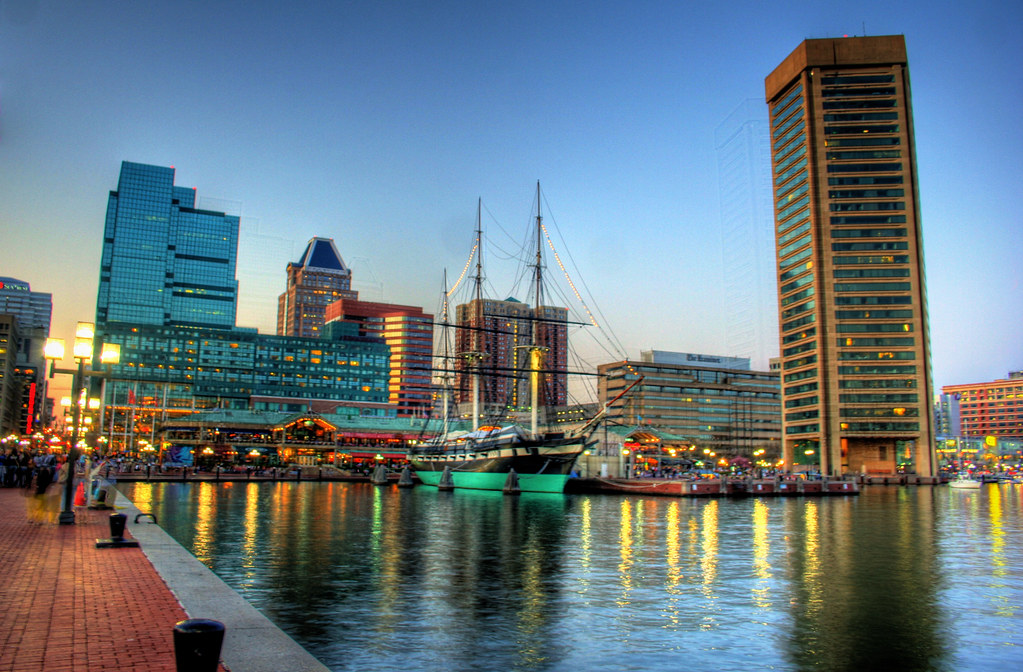
Baltimore, Maryland. Photo by Kevin Labianco via Flickr.
The Baltimore metropolitan area is planning for the region’s future development thanks to a Regional Planning Grant from the Department of Housing and Urban Development (HUD), part of the Partnership for Sustainable Communities.
The Opportunity Collaborative for a Greater Baltimore Region spans a diverse landscape ranging from the dense urban streets of Baltimore to the rural, pastoral landscapes of Northeastern Maryland. The project encompasses Baltimore City, Baltimore County, Howard County, Carroll County, Harford County and Anne Arundel County – an area home to more than 2.5 million people.
The local governments, state agencies, universities and nonprofit organizations working on the project aim to improve the quality of life and economic vitality through comprehensive planning for the region. Focusing on growth, housing, transportation and workforce development, in addition to protection of the Chesapeake Bay, the Collaborative will produce a Regional Plan for Sustainable Development (RPSD), as well as a supporting Regional Housing Plan and a Regional Workforce Development Plan. The Collaborative has also adopted Plan It 2035, a 2011 Baltimore Region Transportation Plan, as their vision for the region’s transit future. The RPSD is the first joint, ongoing effort by Baltimore area governments, private organizations and businesses to address regional planning issues with a consortium consisting, almost equally, of government and non-governmental partners.
The Regional Workforce Development Plan, projected to be released in the spring of 2014, will work to identify gaps between the region’s training and employment opportunities, analyze hurdles faced by underserved populations toward upward mobility, and facilitate career pathways in the region’s key industries.
Meanwhile the Regional Housing Plan will conduct a demographic analysis of current housing to identify trends as well as areas in need of attention. A market analysis will assess the overall health of the housing market, examining inequity in both the rental and for-sale housing markets. The accompanying Fair Housing Equity Assessment will identify impediments to equal housing opportunity, analyzing the impacts of race, ethnicity and the physical infrastructure of neighborhoods.
Mike Kelly, General Counsel for the Baltimore Metropolitan Council and Project Director for the Opportunity Collaborative, spoke of how the Housing, Workforce and Transportation plans will support the RPSD. “When we build our RPSD, we will have three policy analyses to link together,” he said. “You can’t talk about a transportation network without talking about how it can connect people to jobs.”
Community engagement and education are built in to the development of the RPSD. The Collaborative is reaching out to underserved communities, grassroots organizations and key businesses and employers in the Baltimore Metropolitan Region to provide a comprehensive voice for residents’ concerns. The Collaborative has also created a web portal to foster discussion of planning issues and residents’ visions for Baltimore’s future.
The project officially launched on March 25, 2013 at an event at the University of Baltimore Student Center. The kickoff event featured remarks by Howard County Executive Ken Ulman, who spoke of the importance of the Opportunity Collaborative’s work:
“We need to think regionally about jobs and transportation. The future vitality of our region rests on connecting people with good jobs in the smartest and most efficient ways. It means identifying and promoting job centers, making sure the transportation networks are in place so that workers can get to those jobs, and providing training needed for good careers. This Collaborative is the perfect forum for those discussions.”
To get the project’s work under way, the Collaborative is providing grants for “small-scale, replicable” projects that embody the types of community initiatives and assets the project seeks to foster. In November 2012, the Collaborative awarded its first of two rounds of $375,000 to eight diverse local projects. The grants range from transportation initiatives increasing access to employment centers, to an initiative increasing awareness of the connection between neighborhood trash disposal behavior and the cleanliness and health of local waterways.
The City of Aberdeen in Harford County was one of the initial winner. Aberdeen will use a demonstration grant to facilitate transit-oriented development. The city has seen significant growth thanks to a major government investment in jobs and real estate surrounding the Aberdeen Proving Ground, a local military facility. Aberdeen hopes to create better connections to the DC/Baltimore Corridor, and the demonstration grant supports a change in local zoning codes to promote development centered on a train station that is experiencing a significant increase in demand. The local Aberdeen community and officials view the chance for denser development as an important economic development tool.
The Anne Arundel County Partnership for Children, Youth and Families also received a demonstration project grant to fund its Green Housing/Grow Jobs program. The program will train 10 public housing residents to retrofit lighting and improve energy efficiency at the Housing Authority of the City of Annapolis. Participants will receive job assistance and career mapping that will lead to apprenticeship training and permanent employment. The program provides a pathway to employment for a community hit particularly hard by the recession.
The Opportunity Collaborative is planning for an economically vital, equitable, and environmentally conscious future for the “Charm City” region. The project is strongly supported by local government leaders and organizations, co-chaired by the Mayor of the City of Annapolis, Joshua Cohen, and Scot T. Spencer of the Annie E. Casey Foundation. Mr. Kelly spoke of the public perception of the project, stating, “There’s a lot of interest in what were doing.”
Thanks to the investment of the Department of Housing and Urban Development’s Sustainable Communities Initiative, the Baltimore metropolitan region is working to make lasting, positive change in its communities.